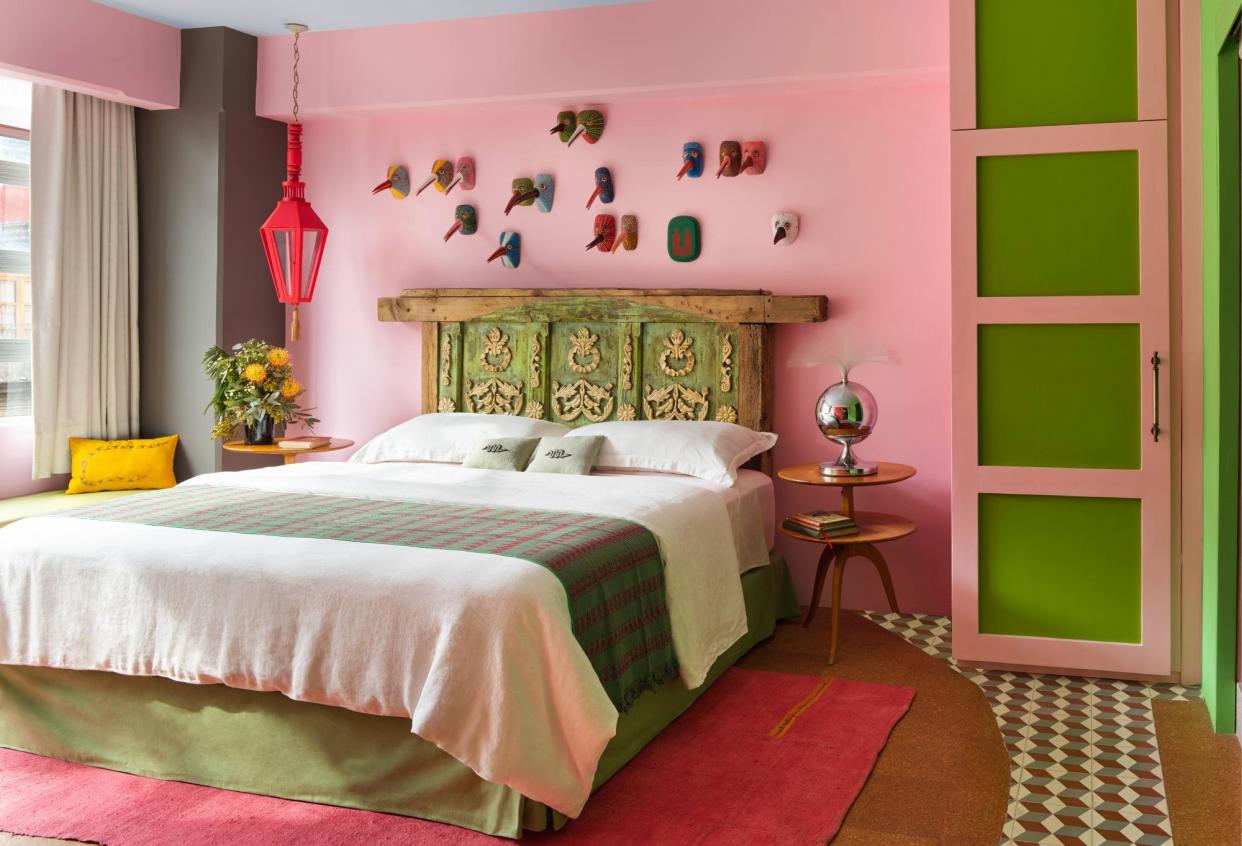All play and no work: a fun renovation in Mexico City

How do Europeans live in such grey, beige places? I’m happy waking up in a pink room. Vibrant colours make you joyful; you will never be sad with pink and red,” laughs artist and gallery owner Carlos Rittner from his apartment in Mexico City.
From the exterior, the 1940s converted office block, which is a stone’s throw from the Zócalo plaza, the world’s largest city square, is modest, but step through the banana-yellow front door and you are instantly transported into an art installation.
Cobalt-blue walls frame the gamboge entrance, while a sheet of black plastic tarp along one wall is tied down with neat geometric strings, an ode to the South American lorries transporting goods across central and south America. Shimmering either side of a large Aztec-inspired mosaic is a pair of golden pendant Casamidy lights framing the scene.
Mexico City is built on the crumbling remnants of its indigenous past, the ancient floating Aztec metropolis of Tenochtitlan. “You can feel the history here,” says Rittner, who employed his friend, LA-based interior designer Jessica Ayromloo, to help with the design. “I sleep where there have been more than 1,000 years of tribal revolutions, folklore, conflict, palaces and power.”
The apartment had been sliced in two – badly – and used as an Airbnb. The first thing Rittner and Ayromloo did was to begin ripping everything out, including the walls, and add an extra bathroom. Inspired by indigenous architecture, the spare bedroom was designed as a trapezoid – the curved walls include a hidden sliding door, but it is more often closed off with a red theatrical curtain.
The wavy moulding on a former convent, now a library, seen from the window on the street opposite supported the pair’s curvaceous theme, which meanders around the sitting-room walls with a flowing wiggly shelf and spills on to the floor to meet the rounded edges of cork flooring. The sheets of cork, in turn, knock against lines of local Rayito de Sol concrete tiles, influenced by the exterior of a 17th-century church, composed of tart yellow and electric blue, alongside a meld of grey, burgundy and white diamonds. Each of the different floors merges to meet in a glorious, clashing triumvirate at the centre of the apartment.
“I followed the form of the circular room and began playing around like a kaleidoscope with different floor tiles,” explains Ayromloo. “Although it feels like it should clash, I laid them out in a composition where your eye connects the dots, like a triangle, creating balance from all the different colours.”
By Mexican standards, the kitchen is tiny – a simple industrial affair with a frilly curtain to hide the bin and dragon-shaped sconces from a flea market holding up a shelf. Rittner prefers to eat on the streets of the city. “Literally,” he explains, “you can reach your arm out when you are sitting at one street food vendor and touch the next one.”
Across the capital, the influence of famed local architect Luis Barragán is on display – named World Design Capital in 2018, the city has been involved in a deep love affair with pink, thanks to Barragán’s florid use of it. Naturally it needed to be included in the design; the main bedroom is steeped in its calamine arms, courtesy of Mexican paint Comex.
An antique carved door discovered in the Callejón de los Sapos, in the state of Puebla, has been repurposed as a grand wooden headboard, its acid-green notes expanded further into the room, on the panelling, door frame and even the bed valance. Red details draw the eye, while a crowd of multicoloured, long-beaked masks from La Lagunilla market adorn the wall.
Inspired by Diego Rivera and Frida Kahlo, Ayromloo and Rittner sought to recreate Rivera’s art studio’s avocado-green cabinetry in the living room. Salvaged ironwork pieces, attributed to midcentury Mexican designer Arturo Pani, were integrated into the sofa design and are used to quietly partition the open living spaces.
Rittner, who has worked as an art teacher, set designer and in the interiors industry, recently opened Artbug, a gallery in Los Angeles, a hotspot for Latin American and Chicano artists. Like Ayromloo, he is obsessed with colour and detail; the pair spent hours rummaging through markets and antique shops, exploring art studios and galleries across the city. Devouring tacos from street stalls, they bought old door handles, chairs and sconces for the apartment. “We were inspired and acted in the moment, it was freestyle, which makes it seem more like an art piece. The spontaneity was instinctual, it was special, and I think that is because of our friendship,” smiles Ayromloo.


